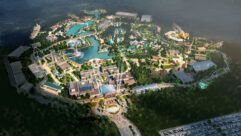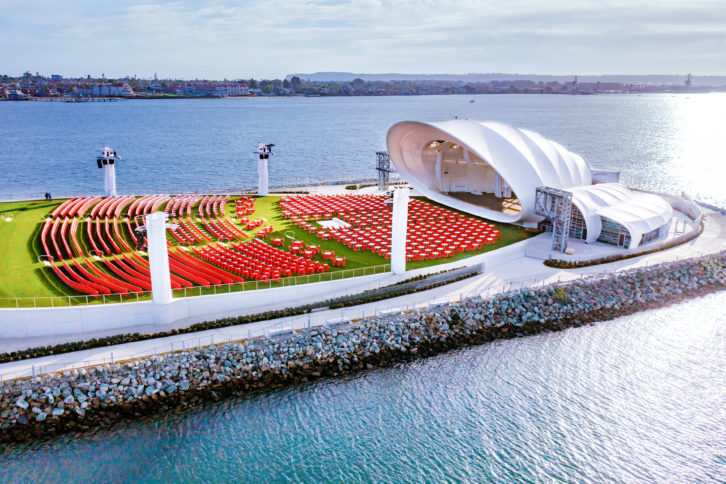
SVC: We’re joined by Solotech Senior Engineer Aaron Beck with the story on how they got the systems in and working at the Rady Shell. Before we dig into this project, how’s it going for Solotech?
Aaron Beck: You know, like several of us in the industry, the fact that Solotech has two divisions, live production and integration, really helped us get through. The sales and integration side is construction-based and construction didn’t really shut down. We had several active projects and some new projects that kept that side going the whole time. We’re now close to 14 offices across the world. In the United States we have six offices; three in Florida, a Nashville office, a Vegas office and an LA office for the Solotech. U.S. corporation, and our headquarters are up in Montreal.
The project for the San Diego Symphony sounds like something major even for your company. Can you set the scene?
It’s right on the Bay, just to the west of the convention center in downtown San Diego. It’s a project that the symphony has had on their minds for many, many years. Up until recently they would set up a portable stage around Memorial Day and keep it up through Labor Day and do summers outside with the symphony. But they really had a vision and a dream to build a permanent world-class outdoor venue for the symphony and the timing was right to make it happen.
This is the Rady Shell in Jacobs Park, San Diego and it was designed to complement the existing convention center nearby?
Yeah. The convention center is just to the west of it and has a similar type stretched plastic roof. I think the architect kind of tried to tie the two together. But yeah, that’s kind of just to the west of the convention center there.
This is primarily the home of the San Diego Symphony but a wide range of other performances go on there and it has to be adaptable to suit all those events. How big of an audience area is there?
I think for the symphony for the most part they’re going to be at 3,000-5,000 seats. There’s a lawn area in the back that you can bring a blanket and sit down. They’ve got regular rows of chairs. They’ve got some seats that have a little table in between them. And then down front they’ve got round tables with four chairs so it’s really nice to sit with a cocktail, or a glass of wine, or a meal and enjoy the music. That’s their take, but I think it could be adapted for up to 10,000 if they were to do traditional seating across the whole area.
I think there’s something like thirteen thousand square feet on the stage.
Yeah, it’s big. I think the stage is around 90 feet wide, about 60 feet deep, and about 35 feet tall inside the shell there. They talked about wanting a venue that was really flexible. It’s certainly home of the symphony, but I think the goal is that they’ve got guest artists in there two to three nights a week. And instead of just running from Memorial Day to Labor Day, I think the hope is that they could be doing shows as early as some point in March and run all the way until November because of the weather in San Diego certainly can support that. We tried to make sure the system was designed with enough flexibility and could support everything from the symphony all the way up to a pretty loud rock performance, if needed.
Any way you look at it, fitting out this fantastic new venue was a major undertaking even for a big AV company. What did they need you to do?
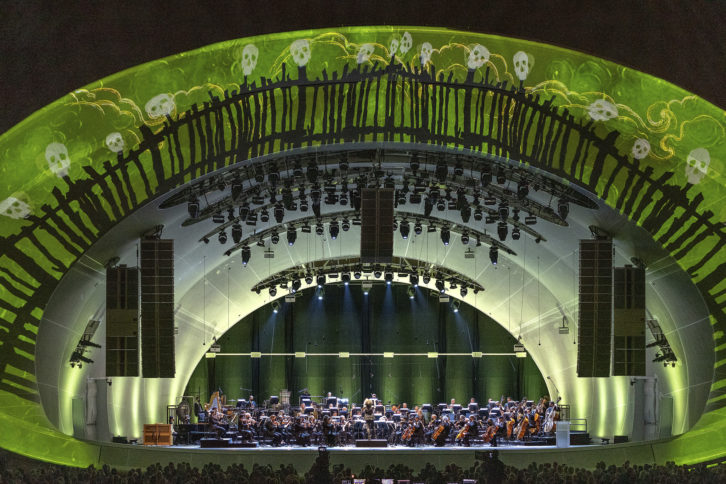 We were certainly the integrator for the audio, the video and lighting infrastructure, and the lighting control network onsite. It has an L-Acoustics main performance system. It also has a Meyer Sound Constellation system on stage specifically designed for the orchestra. They really wanted to make sure the orchestra members themselves felt like they were in a performance space and not just outside. The Meyer Sound Constellation system allows them to really hear themselves and basically it’s created an electronic orchestra shell on stage, so it creates those reflections that they would hear on stage. And then in terms of control there are three DiGiCo consoles; there’s Shure wireless. All of the audio travels around the site on an Optocore fiber optic network. So those are some of the main components of the audio system. The video system is a mix of some Sony and Panasonic cameras that feed through some Blackmagic switchers, and there are three large Planar LED screens for the audience–two IMAG screens left and right and then a center screen that can be taken up and down based on the event. And then like I said, the lighting control is all ETC for backbone and for DMX control and power.
We were certainly the integrator for the audio, the video and lighting infrastructure, and the lighting control network onsite. It has an L-Acoustics main performance system. It also has a Meyer Sound Constellation system on stage specifically designed for the orchestra. They really wanted to make sure the orchestra members themselves felt like they were in a performance space and not just outside. The Meyer Sound Constellation system allows them to really hear themselves and basically it’s created an electronic orchestra shell on stage, so it creates those reflections that they would hear on stage. And then in terms of control there are three DiGiCo consoles; there’s Shure wireless. All of the audio travels around the site on an Optocore fiber optic network. So those are some of the main components of the audio system. The video system is a mix of some Sony and Panasonic cameras that feed through some Blackmagic switchers, and there are three large Planar LED screens for the audience–two IMAG screens left and right and then a center screen that can be taken up and down based on the event. And then like I said, the lighting control is all ETC for backbone and for DMX control and power.
That’s top of the line equipment. Why did you decide to go with three DiGiCo mixers? You have one at front of house, another one for stage monitoring and how do they use the third one?
Yeah, so the SD7 is the main front of house desk for the symphony. Then on stage there’s a SD10 that has a monitor console if they’re going to do a pop act. And then we have a smaller SD12 that lives at front of house as a utility mixer. There are some pretty stringent noise requirements around the site, both for onsite and for what sound pressure level reaches Coronado Island, which is just to the west. So the thought is that if there’s a guest artist, the guest console would always feed through the SD12, which would give the onsite staff member ultimate control of level and if it needed to be turned down certainly they could do that pretty quickly. In terms of noise and restrictions there’s a total of three NTi measurement microphones, two on the island itself and then one on Coronado across the bay. So the onsite audio team can get a text alert if those three positions reach a certain SPL limit. They’re really able to keep track on what the system is doing across that big property.
That’s a huge job, keeping in mind all the vastly different types of performances they have to be able to accommodate.
It’s a lot. It’s a big site. One of the funniest things that I’ve seen onsite is a lot of the crew has the little powered scooters just to be able to get around quickly because it will take you five minutes to walk from the stage to Building B, which is in the back of the venue under the lawn where the video control suite is. So yeah, it’s a lot to keep up with outside in an environment right on the water; it’s going to take some upkeep to keep things going. There’s a team. Jason Rothberg is the production manager/technical director. Joel Watts is the audio director for the site.
And you have the SD racks that support the mixers?
Yeah. There are three fully-loaded SD racks with the 32-bit input cards on stage. Everything is running at 96kH. Shawn Murphy, the consultant and sound designer for the symphony was really particular to make sure that we maintained 96k throughout the system and it really does sound fantastic.
For playback getting that set up for immersive sound is a pretty tall order, especially outside.
Yeah, they just didn’t want to do a traditional left/right. So the six towers out on the lawn gave us the ability to hang the L-Acoustics A Series as side surrounds. And then the two towers in the back gave us the ability to do rear surround. And specifically, I think, those will get used a lot for when they do the movie nights, whether it’s an orchestra playing the soundtrack live to a movie or a recording, the ability to have that surround system makes the venue even more unique. Another way we’re achieving that sense of immersion is by taking some of the reverb returns from the front-of-house console and sending them to the surround speakers.
For the low end I think they have something like sixteen of the L–Acoustics K28 subs installed under the stage?
There are sixteen under the stage and eight flown per side, so it’s a total of 32. And really it could be done with less, but having that quantity really gave us the ultimate control in terms of steering and control of the low end to try to make sure we kept it on the site and we weren’t just throwing low end energy everywhere around the venue.
That’s the tough part. Controlling the low end being much less directional.
Yeah.
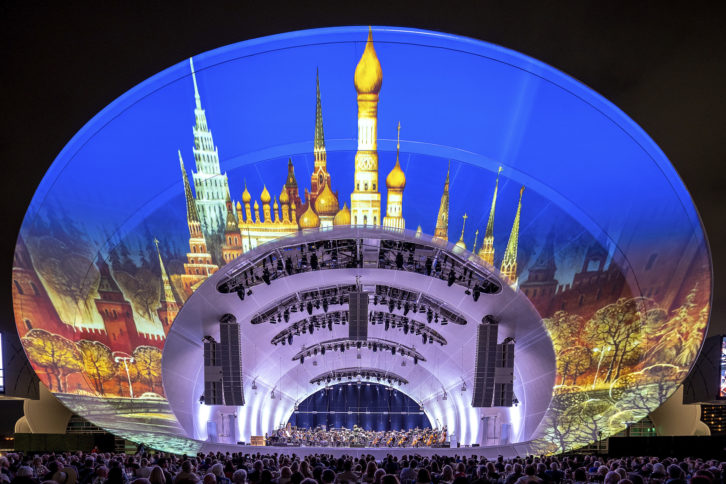 So why was the L-Acoustics K2 system chosen? For controllability or was it the outside weather factor?
So why was the L-Acoustics K2 system chosen? For controllability or was it the outside weather factor?
It was a little bit of everything. Certainly it’s one of the most rider-friendly systems out there, and knowing that the venue was going to be used for guest artists and touring played into it. Several of the symphony team had experience with the product before so they were aware of it. And then in terms of technical specs the asymmetric L-fin really was one of the deciding factors that allowed us to kind of keep the box aimed where we wanted it to, but then also control that high frequency spill off the site. And then certainly just the being outside we felt like its durability would be a really good long term investment. Having the venue be so close to saltwater can be pretty harsh on sound components, and the temperature swings here can also be dramatic.
And I notice the speaker housings are in a distinctive white finish.
They are. The white exterior wrapping material is a kind of plastic cloth and the interior is covered with a white scrim material. Anything in the shell, against that white canopy, the requirement was to do white so it blended in as much as possible. So the flown K2s, the flown KS28s are all custom white finish.
The only other place I think they have that is the Hollywood Bowl.
I believe that is correct.
You mentioned at the beginning that you set up an Optocore fiber network to connect all of the audio control points.
Yeah. With the site being as large as it is we felt like fiber optic transmission was the way to go both from a distance and a future proof. And then the Optocore system really gives the end user the flexibility to change patching via the software so if a guest artist is coming in and they need to repatch things, it’s really easy without going to an analog patch bay. You can open the Optocore software and quickly change and reconfigure the system as needed.
What was the L-Acoustics app that was used to design the system?
Soundvision is their modeling software.
And who used that to design the whole sound setup?
There were a couple of people. Tom Schindler at Salter was one of the consultants who worked closely with Shawn Murphy for the symphony and then Frankie Desjardins out of our Montreal office. The three of them came up with the overall design concept for the main system and then certainly Meyer Sound and their engineering team and Constellation team came up with the overall design for the onstage Constellation system for the musicians.
Solotech did the lighting–that must have been an interesting job because of the whole shell having a translucent material all over it.
Yeah, but certainly the white background really allows the colors to pop and to give them a lot of flexibility. For the opening weekend they rented a projection system and they did projection-mapped content on the front and top of the shell itself and it really kind of gave a unique experience to that opening weekend.
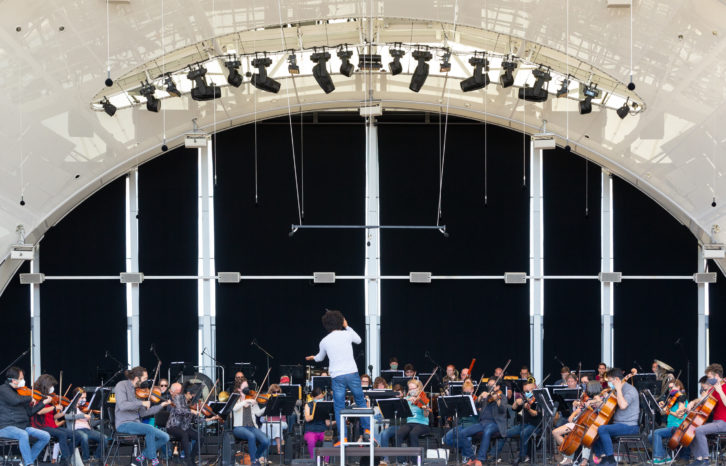 Thanks for giving us the story on how you got it all done.
Thanks for giving us the story on how you got it all done.
Yeah. Thanks for your time today. Super proud of our team for the project. And if you’re in San Diego it’s definitely worth checking out, enjoying a concert in a fantastic venue.
Power and Control
The PA system comprises two main arrays of 16 L-Acoustics K2 per side, flanked by two hangs of eight cardioid-configured KS28 subs per side and a center array of nine K2s. Another 16 KS28s, also in cardioid configuration, are located underneath the stage. Six towers comprise the surround elements of the 7.1-type system design: two side-surround towers per side (for a total of four) hold four A15 Focus speakers each, with the rearmost tower on each side also holding six Kara II with mechanically adjustable HF-steering fins. Two rear-surround towers are fitted with four Kiva II and two SB15m subs each. The system is powered by two dozen LA12X amplified controllers, with system processing by L-Acoustics’ LA Network Manager.
San Diego Symphony Audio Director Joel Watts says that this sound system is highly unique and particularly effective for amplifying a symphony orchestra in an outdoor environment. “In a space like this, where the seating goes back a full 200 feet, the only way to fill it with acoustical music, is with amplification. But it has to be done in such a way that everyone hears only the music, never the speakers,” he explains. “And that’s especially true of a surround system like this.” Watts also points out that the asymmetric configuration and precise placements of the speakers allow the orchestra to achieve full impact without exceeding the noise restrictions. “We have full dispersion to one side of the system and virtually none to the other side, thanks to the fins on the K2,” he says. “It focuses the sound and keeps it on the seats. It never crosses the lease line.
Constellation First
To create an optimum acoustical listening environment that can be fine-tuned for various performances, a Meyer Sound Constellation acoustic system has been installed inside the shell — making it the first Constellation system designed for stage acoustics in an outdoor venue.
“The sound onstage is unbelievable,” said San Diego Symphony Music Director Rafael Payare. “We can hear each other wonderfully and you feel like you are in one of the top-notch concert halls of the world.
Equipping the shell structure with an active acoustic system for monitoring was strongly recommended by Shawn Murphy, an Oscar-winning film score mixer (and frequent FOH engineer for high-profile outdoor orchestral events) who served as special consultant to the symphony. Meyer Sound’s Constellation team designed the acoustic system, with complementary physical acoustics entrusted to Salter, the project’s acoustical and AV consultant.
Because many performances at the venue — most notably amplified pop or rock — would not use the Constellation system, the Salter team was given a two-fold brief: design a baseline acoustic that would support Constellation but would also provide a good environment when Constellation was off.
“As far as the acoustic signature inside the shell, it is quite similar to a large Hollywood sound stage,” says Salter Vice President Jason Duty, who took over as principal acoustician on retirement of David Schwind. “It has a mixture of diffusive and absorptive elements, but little for reflection across the stage because that is handled by Constellation. We didn’t want it totally dry, as they wanted the stage to have a bit of life when the system was off. We definitely understood what the Constellation team was looking for.”
For Duty, the shell structure’s size, location and variety of performance styles made active acoustics the preferred solution. “Constellation is incredibly helpful in situations like this. The venue is right on the harbor, and having the control to let musicians clearly hear players on the other side of the stage is beneficial. In addition, there is the flexibility to adjust the acoustics to what you are hearing in the moment.”
As installed, the Constellation system comprises 25 UPM-1XP and 22 UPJuniorXP remotely selfpowered loudspeakers, with 12 UMS-1XP remotely self-powered subwoofers to extend the reverberation envelope to the lowest registers. DSP for driving the system is supplied by an eight-module DMitri digital audio platform, with two modules dedicated to hosting the patented VRAS variable room acoustic algorithm. Ambient sensing for the regenerative reverberation is provided by 20 Schoeps MK41 microphones with CMC6 preamps.
For music director Payare, the technical wizardry results in one simple outcome: a better environment for playing music. “From the very first rehearsal we had at The Shell, it was fantastic,” he told the Union-Tribune. “The Shell has a mind-blowing, organic quality. You actually can hear the (different sound) balances and perform the way you would in a concert hall, not an outdoor venue.”
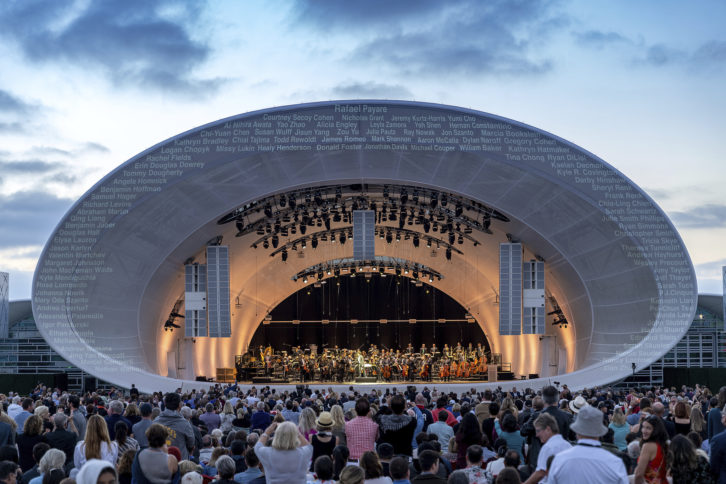 Additional Credits
Additional Credits
Tom Schindler of Salter took charge of AV system design, with Joshua Grossman contributing on behalf of Schuler Shook Theatre Planners and Lighting Designers. System integrator for the project was Solotech. Architect Greg Mueller of the San Diego-based firm Tucker Sadler Architects was lead designer and architect of record, and Soundforms and its London partners Flanagan Lawrence, Expedition and ES Global designed the performance shell. Rob Webster of Gardiner & Theobald provided design and construction project management, and Vice President of Venue Operations Travis Wininger served as a project liaison on behalf of the San Diego Symphony.


